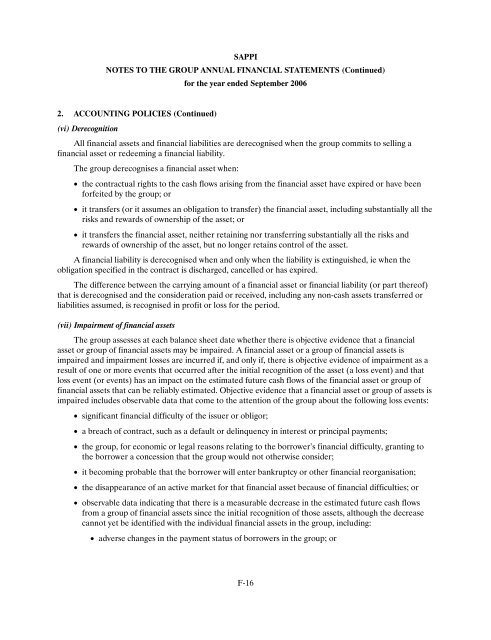Create successful ePaper yourself
Turn your PDF publications into a flip-book with our unique Google optimized e-Paper software.
SAPPI<br />
NOTES TO THE GROUP ANNUAL FINANCIAL STATEMENTS (Continued)<br />
for the year ended September <strong><strong>20</strong>06</strong><br />
2. ACCOUNTING POLICIES (Continued)<br />
(vi) Derecognition<br />
All financial assets and financial liabilities are derecognised when the group commits to selling a<br />
financial asset or redeeming a financial liability.<br />
The group derecognises a financial asset when:<br />
• the contractual rights to the cash flows arising from the financial asset have expired or have been<br />
forfeited by the group; or<br />
• it transfers (or it assumes an obligation to transfer) the financial asset, including substantially all the<br />
risks and rewards of ownership of the asset; or<br />
• it transfers the financial asset, neither retaining nor transferring substantially all the risks and<br />
rewards of ownership of the asset, but no longer retains control of the asset.<br />
A financial liability is derecognised when and only when the liability is extinguished, ie when the<br />
obligation specified in the contract is discharged, cancelled or has expired.<br />
The difference between the carrying amount of a financial asset or financial liability (or part thereof)<br />
that is derecognised and the consideration paid or received, including any non-cash assets transferred or<br />
liabilities assumed, is recognised in profit or loss for the period.<br />
(vii) Impairment of financial assets<br />
The group assesses at each balance sheet date whether there is objective evidence that a financial<br />
asset or group of financial assets may be impaired. A financial asset or a group of financial assets is<br />
impaired and impairment losses are incurred if, and only if, there is objective evidence of impairment as a<br />
result of one or more events that occurred after the initial recognition of the asset (a loss event) and that<br />
loss event (or events) has an impact on the estimated future cash flows of the financial asset or group of<br />
financial assets that can be reliably estimated. Objective evidence that a financial asset or group of assets is<br />
impaired includes observable data that come to the attention of the group about the following loss events:<br />
• significant financial difficulty of the issuer or obligor;<br />
• a breach of contract, such as a default or delinquency in interest or principal payments;<br />
• the group, for economic or legal reasons relating to the borrower’s financial difficulty, granting to<br />
the borrower a concession that the group would not otherwise consider;<br />
• it becoming probable that the borrower will enter bankruptcy or other financial reorganisation;<br />
• the disappearance of an active market for that financial asset because of financial difficulties; or<br />
• observable data indicating that there is a measurable decrease in the estimated future cash flows<br />
from a group of financial assets since the initial recognition of those assets, although the decrease<br />
cannot yet be identified with the individual financial assets in the group, including:<br />
• adverse changes in the payment status of borrowers in the group; or<br />
F-16
















